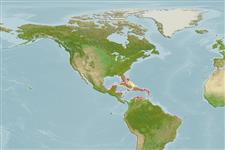Common names from other countries
Environment: milieu / climate zone / depth range / distribution range
Sinh thái học
; Mức độ sâu 0 - 2 m (Ref. 2022). Tropical
Western Central Atlantic: USA, Colombia and the West Indies.
Length at first maturity / Bộ gần gũi / Khối lượng (Trọng lượng) / Age
Maturity: Lm ? range ? - ? cm Max length : 3.8 cm TL con đực/không giới tính; (Ref. 281)
Maximum Total Length: 3.8 centimeters. Body: Elongated; has girdle that covers most of the valves. Valves: Have four clumps of long, glassy bristles near the anterior valve and one on each side of the other valves. Clumps: Set in cuplike collars of the girdle. Pustules: Tiny, round, sharply raised; covering end valves and lateral areas of middle valves. Dorsal longitudinal ridge: Raised, narrow, distinct and smoothish except for very fine pinpoints. Lower edge of the girdle: Dense fringe of brown or bluish bristles (Ref. 281).
Upper sublittoral, under stones and coral rubble (Ref. 2022, page 123).
Life cycle and mating behavior
Chín muồi sinh dục | Sự tái sinh sản | Đẻ trứng | Các trứng | Sự sinh sản | Ấu trùng
Members of the class Polyplacophora are mostly gonochoric. Life cycle: Eggs hatch into lecitotrophic planktonic trocophore larvae (no veliger stage) which later metamorphose and settle on the bottom as young adults.
Burghardt, G. and L. Burghardt. 2006. (Ref. 281)
IUCN Red List Status (Ref. 130435)
CITES status (Ref. 108899)
Not Evaluated
Not Evaluated
Human uses
| FishSource |
Các công cụ
Thêm thông tin
Age/SizeSự sinh trưởngLength-weightLength-lengthHình thái họcẤu trùngSự phong phú
Các nguồn internet
Estimates based on models
Preferred temperature
(Ref.
115969): 23.8 - 28.3, mean 27.1 (based on 319 cells).
Vulnerability
Low vulnerability (10 of 100).
Price category
Unknown.
